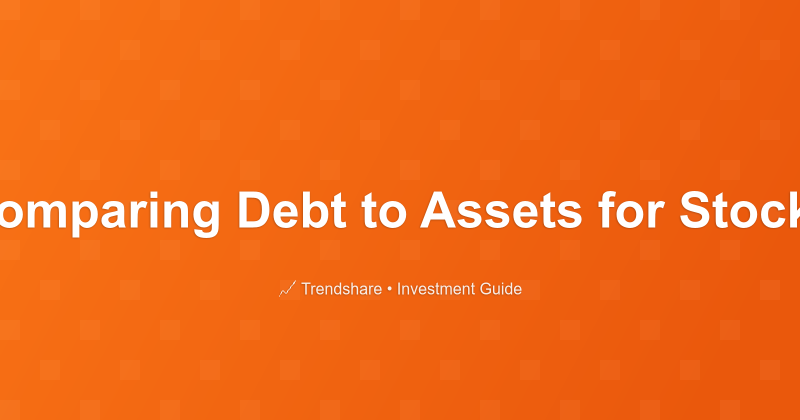
Comparing Debt to Assets for Stocks
By Ethan Mercer
Financial Technology Analyst • 10+ years in fintech and payments
What is the debt to asset ratio? The relationship of a company's debt and liabilities to its assets is vital to its long term survival.
When you buy a stock, you want to get a good value for your money. You don't want to pay too much. If the company's worthless, you don't want to buy it at all. You also need to know what the fair price is to see if you can get a good value.
What is a Company Worth?
What's a stock worth? The question isn't as easy as it seems. There are as many ways to measure the value of a company as there are people trying to measure its value. Of the dozens of measurements, some agree and some disagree. The only way to know for sure is to look into the future.
A business is worth something because it has assets: any equipment it owns, any inventory it holds, any real estate, any investments, any tax breaks, and whatever else accountants can find to put in the plus column of its balance sheet. If the company had to liquidate everything to pay its creditors today, what could it reasonably expect to get for everything it owns?
A business is worth more than that; otherwise you might as well invest in gold. It also has value because it will—hopefully—earn money this year and the year after that and so on. That potential of future revenue has real value that people will pay for. This is where estimates get tricky.
What is the Debt to Asset Ratio?
At the most basic level, a company is worth the value of all of its assets minus the cost of all of its liabilities. If you have two thousand dollars and owe one thousand dollars, your net worth is one thousand dollars. So it goes with companies. The debt to asset ratio is a measurement of how much the company owes in liabilities compared to what it possesses in assets.
This is a good basic rule of thumb. A company with a debt to asset ratio of under 1 owes less than it can currently pay. A company with a ratio of 10 owes far more than it can pay. (Some debt is good debt, and debt can give you leverage, but debt must be serviced.)
Of course, a simple ratio doesn't tell the whole story. A million dollars worth of real estate in the middle of a thriving metropolis is different from a million dollars worth of real estate in the middle of a desert in its fifth year of drought, in the same way that ten million dollars worth of gold in inventory is different from ten million dollars worth of potatoes—especially next year and the year after that.
You can go crazy trying to figure out a single way to measure the value of any one company, let alone every company which has issued public stock.
How Do You Evaluate a Stock?
Fortunately, a rule of thumb is a good place to start: it's better to have more assets than liabilities. If you have a hundred dollars of debt and a hundred dollars in cash, you're doing okay. If you have no debt or if you have two hundred dollars in cash, even better.
When you evaluate a stock, look at the financial statements. Compare debt to assets. A company with more debt than assets (or debt to equity) isn't worth as much as a company with more assets than debt. Certainly the type of that debt and those assets matter, but even as a first simple filter, look for companies with more assets than debt. If you know more about the company and its business and can understand where those assets are (is it a million dollars of potatoes or a million dollars of gold?), you have an edge!
Many measurements measure the ratio of debt to assets. Two in particular are reasonable and accurate and easy to understand: the Current Ratio and the Quick Ratio.
Limitations of Debt and Asset Analysis
With any simple financial ratio, relying on a company's quarterly or annual financial statements can illuminate certain features and obscure others. GAAP allows businesses to disclose information, discount other information, and change what you'd think is the plain meaning of words.
In the real world, the only true analysis of whether a stock's company is strong or weak (or its reporting is accurate or misleading) is time. No matter what one single measurement you think represents the longevity of a business—not even free cash flow—predictions can be wrong.
There's hope, though. Good companies have multiple good characteristics, and careful research can reduce your uncertainty. Good companies stand out in their industries and sectors. They have good performance year over year.
Maybe one sector or industry relies heavily on debt funding (automotive, air transportation) and runs in cycles. You can't compare that to a service business with little inventory costs.
Even so, good companies stick around. Even if you have to dig around to find them, they're there and they're available and they can bring you wealth through careful, deliberate investing.
Investment Disclaimer
This article is for educational purposes only and does not constitute investment advice. Stock prices, financial metrics, and market conditions change constantly. Company examples are provided for illustration and should not be considered recommendations. Always verify current data from official sources such as company investor relations pages or SEC filings, assess your own risk tolerance and investment objectives, and consult a qualified financial advisor before making investment decisions. Past performance does not guarantee future results.